| Jean de Fiennes | |
|---|---|
 | |
| Artist | Auguste Rodin |
| Year | 1885-1886 |
| Medium | Bronze cast |
Jean de Fiennes is a sculpture by the French artist Auguste Rodin, first produced between 1885 and 1886. A bronze cast of it is now in the Museo Soumaya in Mexico City.
| Jean de Fiennes | |
|---|---|
 | |
| Artist | Auguste Rodin |
| Year | 1885-1886 |
| Medium | Bronze cast |
Jean de Fiennes is a sculpture by the French artist Auguste Rodin, first produced between 1885 and 1886. A bronze cast of it is now in the Museo Soumaya in Mexico City.
It is an individual nude modello for his group The Burghers of Calais , showing Jean de Vienne, captain of Calais and the youngest of the burghers who surrendered to protect the citizens of Calais. However, de Fiennes' name was only assigned to one of the burghers long after the historical event in 1346.
Rodin made individual modellos of the figures to study the proportions of the figure and how each would emote aspects of the heroic. In one version of the modello for de Fiennes, Rodin he showed the figure's arms tense and fists clenched, while in another he showed his hands open and his arms by his sides. [1]
A second modello has a nude torso with arms extended and palms upwards; from his forearms a shirt is held – a shirt which covers his lower body and his legs. His face is in profile facing left. [2]
A third study shows him with no arms, totally covered by a robe from shoulders to feet, with more hair on his head and with more detail in the facial features. [3] In the final group the figure is clothed but has his arms extended as in the first nude modello. However, overall the figure of de Fiennes in the final group is the one with the most changes from the initial modello.



François Auguste René Rodin was a French sculptor, generally considered the founder of modern sculpture. He was schooled traditionally and took a craftsman-like approach to his work. Rodin possessed a unique ability to model a complex, turbulent, and deeply pocketed surface in clay. He is known for such sculptures as The Thinker, Monument to Balzac, The Kiss, The Burghers of Calais, and The Gates of Hell.
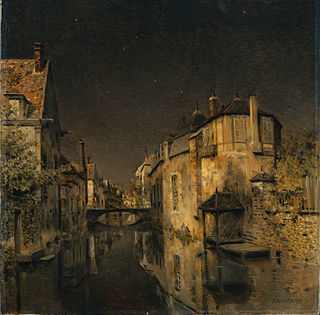
Jean-Charles Cazin was a French landscapist, museum curator and ceramicist.

The Thinker is a bronze sculpture by Auguste Rodin, usually placed on a stone pedestal. The work depicts a nude male figure of heroic size sitting on a rock. He is seen leaning over, his right elbow placed on his left thigh, holding the weight of his chin on the back of his right hand. The pose is one of deep thought and contemplation, and the statue is often used as an image to represent philosophy.

The Burghers of Calais is a sculpture by Auguste Rodin in twelve original castings and numerous copies. It commemorates an event during the Hundred Years' War, when Calais, a French port on the English Channel, surrendered to the English after an eleven-month siege. The city commissioned Rodin to create the sculpture in 1884 and the work was completed in 1889.

The Musée Rodin in Paris, France, is an art museum that was opened in 1919, primarily dedicated to the works of the French sculptor Auguste Rodin. It has two sites: the Hôtel Biron and surrounding grounds in central Paris, as well as just outside Paris at Rodin's old home, the Villa des Brillants at Meudon, Hauts-de-Seine. The collection includes 6,600 sculptures, 8,000 drawings, 8,000 old photographs and 7,000 objets d'art. The museum receives 700,000 visitors annually.
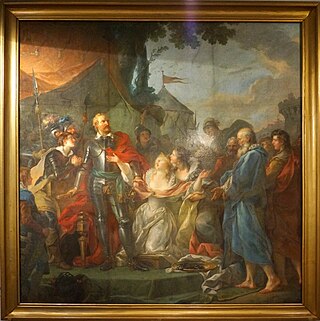
Eustache de Saint Pierre is the best-known figure of the group of six known as The Burghers of Calais, the first to volunteer and surrender, wearing "a shirt and a rope around his neck" to the King of England at that time, Edward III, to save the people of Calais.
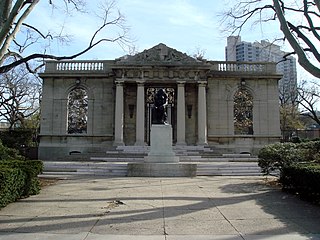

Monument to Balzac is a sculpture by Auguste Rodin in memory of the French novelist Honoré de Balzac. According to Rodin, the sculpture aims to portray the writer's persona rather than a physical likeness. The work was commissioned in 1891 by the Société des Gens de Lettres, a full-size plaster model was displayed in 1898 at a Salon in Champ de Mars. After coming under criticism the model was rejected by the société and Rodin moved it to his home in Meudon. On 2 July 1939 the model was cast in bronze for the first time and placed on the Boulevard du Montparnasse at the intersection with Boulevard Raspail.

Saint John the Baptist (preaching) is a bronze sculpture, by Auguste Rodin.

Modern sculpture is generally considered to have begun with the work of Auguste Rodin, who is seen as the progenitor of modern sculpture. While Rodin did not set out to rebel against the past, he created a new way of building his works. He "dissolved the hard outline of contemporary Neo-Greek academicism, and thereby created a vital synthesis of opacity and transparency, volume and void". Along with a few other artists in the late 19th century who experimented with new artistic visions in sculpture like Edgar Degas and Paul Gauguin, Rodin invented a radical new approach in the creation of sculpture. Modern sculpture, along with all modern art, "arose as part of Western society's attempt to come to terms with the urban, industrial and secular society that emerged during the nineteenth century".
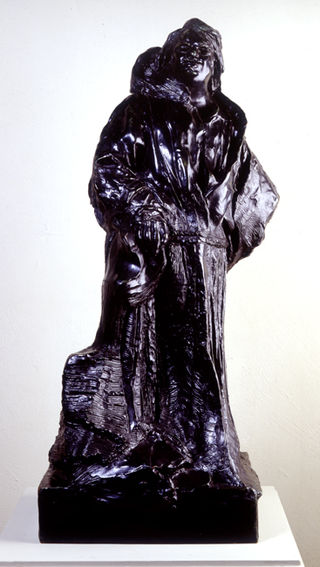
Balzac in the Robe of a Dominican Monk is a bronze sculpture by French artist Auguste Rodin, one of the studies made in preparation to the Monument to Balzac, a tribute to novelist Honoré de Balzac commissioned by the Society of Men of Letters of France in 1891.

Pierre de Wissant is a bronze sculpture by French artist Auguste Rodin, part of his sculptural group The Burghers of Calais. This sculpture represents one of the six burghers who, according to Jean Froissart surrendered themselves in 1347, at the beginning of the Hundred Years' War (1337–1453), in order to save the inhabitants of the French city of Calais from the English laying siege to the city.
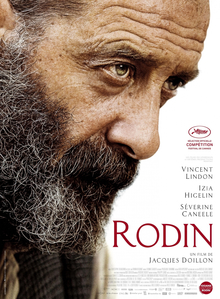
Rodin is a 2017 drama film directed by Jacques Doillon. It was selected to compete for the Palme d'Or in the main competition section at the 2017 Cannes Film Festival. The film received generally negative reviews from the major aggregator surveys.

Eustache de Saint Pierre is a sculpture by Auguste Rodin, now in the Museo Soumaya in Mexico City. It was conceived between 1885 and 1886 as part of his The Burghers of Calais group. The other figures in the group were also cast as individual figures.
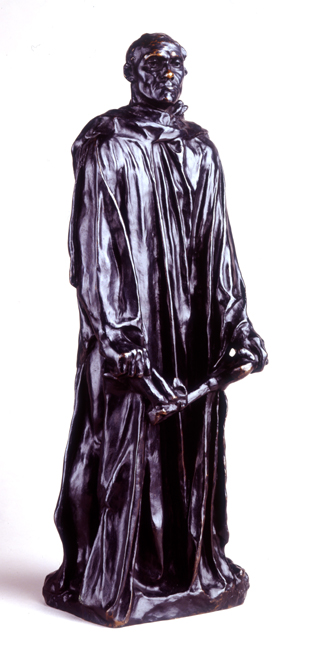
Jean d'Aire is a sculpture by the French artist Auguste Rodin, first conceived around 1885 as part of the planning for his group The Burghers of Calais.

Despair or Despair at the Gate is a sculpture by Auguste Rodin that he conceived and developed from the early 1880s to c. 1890 as part of his The Gates of Hell project. The figure belongs to a company of damned souls found in the nine circles of Hell described by Dante in The Divine Comedy. Other title variations are Shade Holding her Foot, Woman Holding Her Foot, and Desperation. There are numerous versions of this work executed as both plaster and bronze casts and carved marble and limestone.
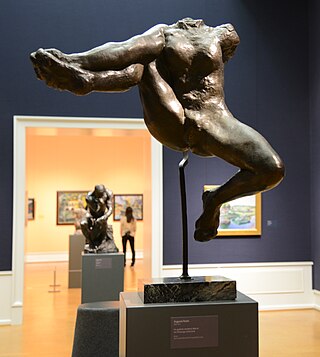
Iris, Messenger of the Gods is a bronze sculpture by Auguste Rodin. A plaster model, created between 1891 and 1894, was cast in bronze by Fonderie Rudier at various times from about 1895. Iris is depicted with her right hand clasping her right foot and her naked body posed provocatively with her legs spread wide, displaying her genitalia.
Andrieu d’Andres is a figure by the French artist Auguste Rodin. It is part of his group of the six figures The Burghers of Calais.
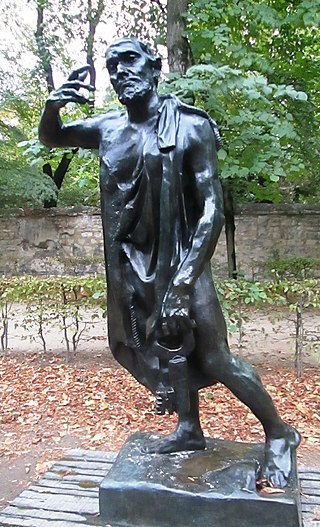
Jacques de Wissant was, together with his brother Pierre, one of the six burghers of Calais. Because of the name, it can be assumed that the brothers are from the village of the same name, Wissant, near Calais.